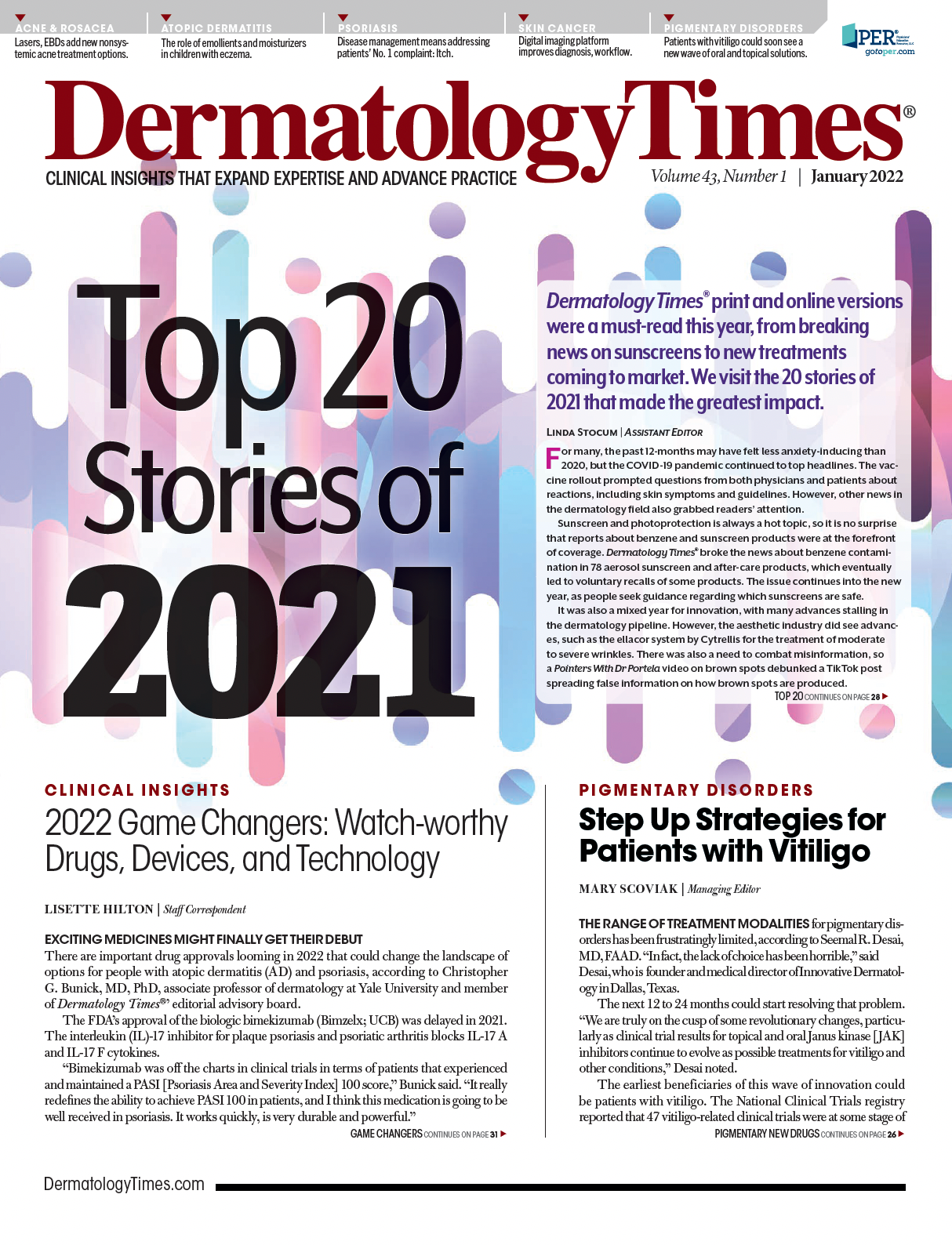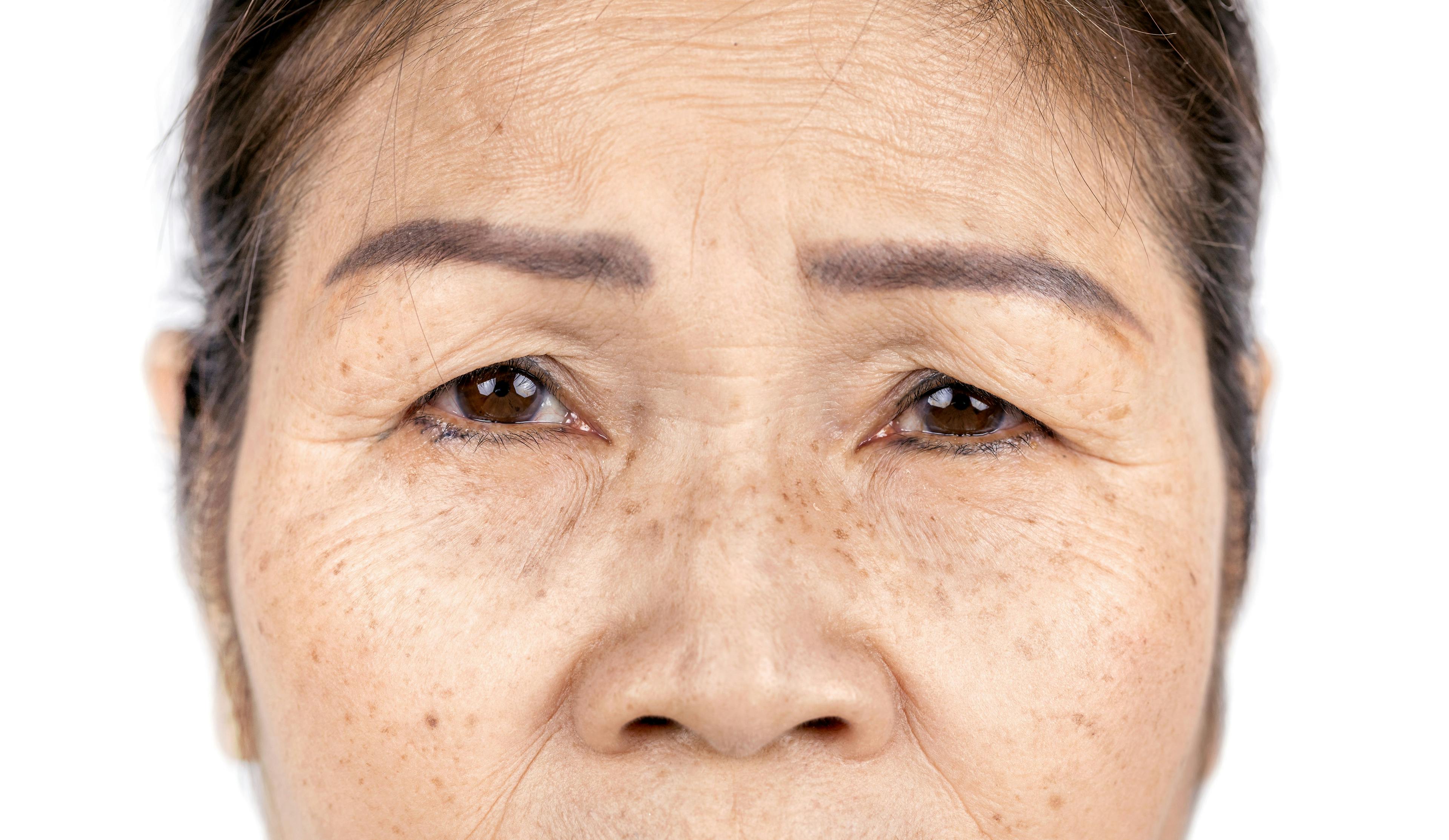- Acne
- Actinic Keratosis
- Aesthetics
- Alopecia
- Atopic Dermatitis
- Buy-and-Bill
- COVID-19
- Case-Based Roundtable
- Chronic Hand Eczema
- Chronic Spontaneous Urticaria
- Drug Watch
- Eczema
- General Dermatology
- Hidradenitis Suppurativa
- Melasma
- NP and PA
- Pediatric Dermatology
- Pigmentary Disorders
- Practice Management
- Precision Medicine and Biologics
- Prurigo Nodularis
- Psoriasis
- Psoriatic Arthritis
- Rare Disease
- Rosacea
- Skin Cancer
- Vitiligo
- Wound Care
Publication
Article
Dermatology Times
Impact of Itch Sparks New Pipeline Direction
Author(s):
Skin sensitivity will be a factor in vehicles for new treatments.
The next wave of advances in topical therapies that treat psoriasis will focus not only on efficacy in achieving clear or almost clear skin but also on patients’ top symptomatic complaint: chronic itch, said April Armstrong, MD, for a non-med- ical continuing education session supported by Arcutis Biotherapeutics and held October 23, 2021, at the 2021 Fall Clinical Dermatology Conference in Las Vegas, Nevada.1,2
Itch is an expected part of any physician-patient discussion about atopic dermatitis (AD) and should be for consultations about psoriasis as well, said Armstrong, who is a professor of dermatology (clinical scholar) and associate dean of clinical research in the Department of Dermatology at the Keck School of Medicine of the University of Southern California in Los Angeles.
“For a long time, even some clinicians considered psoriasis a nonpruritic dermatosis. But patients—especially those with severe disease— tell us that itching is quite, quite bothersome,” she said. “In fact, studies show that itch is the most burdensome and commonly reported symptom of psoriasis. Nearly 90% of patients reported itch as the key symptom in their disease.”1,2
Armstrong recommended that physicians broaden the patient conversation beyond body surface area to include detailed questions on itch. “It’s very important to ask patients about itch, including where they experience it,” she advised. “Based on my experience, what’s fascinating is that patients itch in their lesional areas but, importantly, also in their nonlesional skin. And that really tells us a few things.”
She pointed to lines of evidence supporting the premise that the nonlesional skin of both patients with psoriasis and those with AD may not be normal and has the potential to flare up. “Oftentimes, there is a low level of immune hyperactivity as well as an increased number of neuropeptides in the area that mediate itch,” Armstrong said. “So again, while we typically associate lesional skin with itch, we know that nonlesional skin can itch as well.”
Numerous studies have demonstrated that itch has a ripple effect on quality-of-life and overall health, Armstrong noted. “As physicians, we need to talk to patients and their families about sleep disturbance relating to itch,” she said. “In sleep studies that use nighttime videos, we see that in many cases, the patients unconsciously scratch throughout the night. In other cases, itch can relate to insomnia. It can create problems with falling asleep. Even when patients do sleep, the quality of sleep diminishes because the duration of time that they actually spend in the REM cycle is significantly reduced, so they feel overly tired or sleepy. Oftentimes, that can lead to poor performance during the day at work or school.”
Armstrong recommended use of an itch scale to assess patient perceptions of severity. She prefers the 3 types commonly featured in clinical trials: The numeric scale, with ratings from 0 (no symptoms) to 10 (worst case possible), is the most widely used test.
Armstrong also likes the verbal rating scale for use in the clinical setting—patients can
describe the degree of itch they are experiencing. The visual analog scale, which presents patients with a line on which they mark an X where their itch ranks, is declining in popularity. “Technically, to do it correctly, you’re supposed to use a ruler to measure the distance from the beginning to the end of the line. Who carries a ruler these days?” she commented.
Patient input also can aid in identifying the most effective treatment regimen. “For example, when assessing histaminergic itch vs nonhistaminergic itch, patients often notice that there’s more description of burning, prickling, and stinging associated with nonhistaminergic itch. The quality of itch matters,” Armstrong said
SOLUTIONS BEYOND STEROIDS
Under-recognition of the impact of itch has not just frustrated patients, it also has contributed to a gap in the development of treatment options. Although new medications have produced significant advances in reducing redness and scaling, leading to clear or almost clear skin for many patients, the pipeline for therapies that aim to address itch has been narrow, according to Armstrong. Topical steroids remain the No. 1 choice for treating plaque psoriasis, she said. “This drug class has proved to be effective in treating erythema and scaling,” she added. “Topical steroids also can reduce itch, although oftentimes that reduction is partial or not complete.”
Formulation is key in Armstrong’s view. Penetration enhancers such as propylene glycol significantly help move an active drug molecule into the skin. “The problem is that these penetration enhancers frequently can lead to skin irritation in some patients,” she said. Surfactants used for emulsification can also cause irritation and burn- ing, according to Armstrong.
“So, the challenge with regards to the development of topical therapies is really focused on a treatment that is effective not only in terms of decreasing the signs, the redness, and the scaling of psoriasis as well as reducing itch but also is formulated such that it has a minimal degree of sensitization for the skin itself,” she said. “Itch, therapeutic targets for itch, and the therapies themselves have been really active areas of development lately.”
MOVING FORWARD FROM ANTIHISTAMINES
“When we as dermatologists think about itch, we typically think about histaminergic itch, so most of therapies targeted against itch are antihistamines,” Armstrong said. “That particular paradigm is quite valid when we’re thinking about chronic spontaneous urticaria, for example. However, when we’re thinking about conditions such as psoriasis and [AD], our clinical practice informs us that antihistamines do not work very well...to treat severe itch in our patients.”
There is hope on the horizon, she noted. The explosion of pipeline drugs aimed at AD has led to psoriasis treatments that offer solutions for itch. However, Armstrong cautioned against seeing these breakthroughs as panacea: “I want to highlight the fact that [AD] and psoriasis have different immunological pathways as their main drivers and that the quality of itch associated with each can be quite different.”3,4
In terms of AD, Armstrong said some of the mediators implicated in itch include IL-4, IL-13, IL-31, and—importantly—phosphodiesterase 4 (PDE4), as well as the JAK/STAT pathway. TSLP protein also has been connected with the pathogenesis or at least involvement of itch in AD.
“For psoriasis, some of the players are the same, but there are different ones as well,” she pointed out. “For example, PDE4 is one of the commonly shared mediators for itch. However, for psoriasis, we also see a bit greater involvement in the NK-1 receptor as well as TRK4.”
Turning to neurotrophic and neuronal factors related to AD and psoriasis, Armstrong discussed how the sensory nervous system mediates flow transmission of some of the fibers that play a role in the itch-scratch cycle.
External events such as trauma or infection also can trigger itch. Cytokine receptor signaling leads to the release of alarmins from keratin sites to alert the brain that something is happening, she said. “They can then go to the receptors on our nerves in the skin and bind to the receptors, resulting in transmission of the signal to our dorsal root ganglion in the brain as itching. So, as you can see here, PDE4 can be involved in the initial stage in terms of the reception of the danger signal. That’s 1 pathway.”
Immune cells provide another pathway. Although the helper T cell (TH) 2 pathway is involved with AD and much of that particular signal transmission, PDE4 also plays a big role with regard to the transcription of downstream factors, such as IL-4, IL-13, and IL-31, which ultimately bind to the receptors on the neurons, Armstrong said. In her view, these combined factors point to PDE4 inhibitors as a pipeline drug class to watch. (On October 4, 2021, Arcutis Biotherapeutics a submitted a new drug application to the FDA for its topical PDE4 inhibitor, roflumilast cream [ARQ-151], for the treatment of mild to severe plaque psoriasis and AD. If approved, it would be the first topical PDE4 inhibitor for plaque psoriasis.5)
“Potentially, the next generation of PDE4 inhibitors will really reduce the symptoms but be nonirritating. That’s something already being worked on,” she said. “The immune cells involving psoriasis are different [from those in AD]. Predominantly, we’re talking about TH17 cells and some TH1 cells. At least in part, these cells, through that PDE4 signaling, can go to stimulate the cutaneous nerves and then translate that into what we perceive as itch. The mediators and receptors overexpress psoriasis.
“We still have a lot to learn about itch, and there’s a lot unknown about this,” Armstrong concluded. “Our therapeutic targets are looking at these various mechanisms pretty closely. We also have room for therapies that offer patients vehicles that are nonirritating and that effectively treat all their symptoms as well as signs of disease. We need to use itch scales and track psoriasis’ impact on quality-of-life. And we need to offer patients support, especially kids who are very itchy. They can be quite miserable, so making sure that they have support with their family and that they’re connected with us as well as their pediatricians or mental health experts would be very helpful.”
Disclosures
Armstrong is research investigator and/or scientific adviser to AbbVie, Almirall, Arcutis Biotherapeutics, Aslan Pharmaceuticals, Boehringer Ingelheim, Bristol Myers Squibb, Dermavant Sciences, Dermira, Eli Lilly and Company, EPI Health, Incyte, Janssen, LEO Pharma, ModMed, Nimbus Therapeutics, Novartis, Ortho Dermatologics, Pfizer, Regeneron, Sanofi, Sun Pharma, and UCB. “Innovations in Topical Therapy: The Role of Vehicle in Treatment Decisions” was supported by Arcutis Biotherapeutics.
References
- Elewski B, Alexis AF, Lebwohl M, Stein Gold L, Pariser D, Del Rosso J, Yosipovitch G. Itch: an under-recognized problem in psoriasis. J Eur Acad Dermatol Venereol. 2019;33(8):1465-1476. doi:10.1111/jdv.15450
- Globe D, Bayliss MS, Harrison DJ. The impact of itch symptoms in psoriasis: results from physician interviews and patient focus groups. Health Qual Life Out- comes. 2009;7:62. doi:10.1186/1477-7525-7-62
- Armstrong A. Innovations in topical therapy: the role of vehicle in treatment deci- sions. Presented at: 2021 Fall Clinical Dermatology Conference; October 21-24, 2021; Las Vegas, Nevada.
- O’Neill JL, Chan YH, Rapp SR, Yosipovitch G. Differences in itch characteristics between psoriasis and atopic dermatitis patients: results of a web-based questionnaire. Acta Derm Venereol. 2011;91(5):537-540. doi:10.2340/00015555-1126
- Arcutis submits topical roflumilast cream new drug application to FDA for the treatment of adults and adolescents with plaque psoriasis. Arcutis Biotherapeutics, Inc. October 4, 2021. Accessed December 3, 2021. https://investors.arcutis.com/news-releases/news-release-details/ arcutis-submits-topical-roflumilast-cream-new-drug-application

Newsletter
Like what you’re reading? Subscribe to Dermatology Times for weekly updates on therapies, innovations, and real-world practice tips.





















